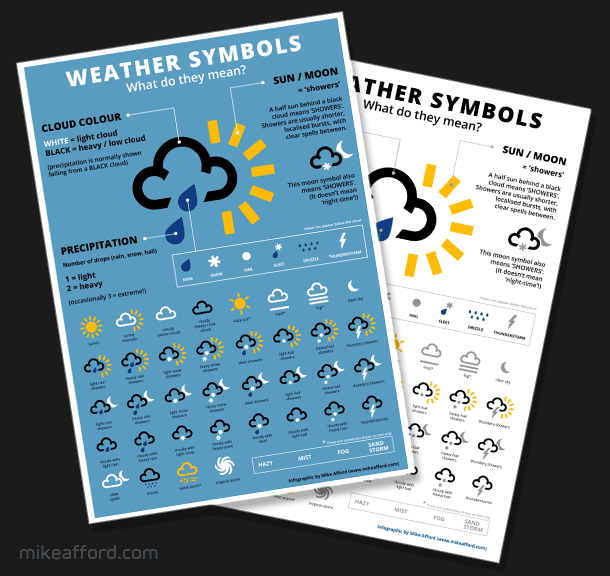Even though it’s been about fifteen years since I worked at the BBC Weather Centre, I’m still surprised at the number of emails I receive asking about the BBC weather symbols, and what they mean.
It’s quite interesting to get a glimpse into the kind of things that people find confusing. Even though the BBC weather symbols have been around for nearly 50 years now, it’s still a bit strange to discover that not everyone ‘gets’ them. For example – the fact that the symbols show the difference between ‘rain’ and ‘showers’ is still often misunderstood.
Basically, ‘showers’ are generally shorter, more localised bursts, and sometimes more intense than regular ‘rain’ (which might be associated with a front and may last for many hours at a time). In the BBC symbol set (and many others) this is indicated by the little ‘half sun’ rays poking out from behind the cloud in the weather symbol. It helps to give a sense that there may well be clear spells in between the showers.
The point being that if you see the little ‘half sun’ on your weather forecast for your area, there’s a chance you might escape the showers altogether, or if you’re caught in one, it hopefully won’t last too long! If it’s just regular ‘rain’ (with no sun poking out on the weather symbol) then there’ll most likely be continuous grey skies, and the rain may be more prolonged / persistent.
Importantly, the same goes for the little crescent moon – it signifies ‘showers’, not ‘night-time’! I’ve lost count of the times I’ve been asked why my ‘cloudy with rain (night)’ symbols don’t have a little moon showing. Well, that’s why. If it had a little moon, it would be ‘showers’ and not (persistent) rain. They’re different weather conditions, with different icons.
Anyway, in the end I’ve decided to create a little ‘infographic’ which explains (I hope) what the BBC weather symbols mean. I thought it might save me some time in the long run – instead of me answering every email enquiry, hopefully anyone arriving at my site might find the little infographic first! It’s available to download in my weather icon STORE along with a bunch of different (royalty free) weather icons that you can download and use in your own projects.
You can download my PDF guide here: Weather Symbol Meanings (Infographic)
I am still very mindful of the fact that the BBC symbols belong to the BBC. So I’ve created a brand new icon set of my own, built from scratch, with many small differences to the BBC versions, but hopefully similar enough so that my symbol guide can be used for both. I think of it as my ‘Arial’ to the BBC’s ‘Helvetica’ – i.e. if you know where to look, you can spot the difference very easily.
Anyway, that’s about it for now. I suppose I’ll only know how useful my guide is, once I see how often it’s been downloaded, and if the email enquiries dry up!
Stay safe!
Mike
P.S. There’s quite a nice explanation of the difference between ‘rain’ and ‘showers’ on the Met Office site here : What is the difference between rain and showers? (www.metoffice.gov.uk).

6 Comments
What does the big black round spot mean on the channel 5 weather forcast. To me it looks like a bowling ball and is only shown on some days of the week. PLEASE EXPLAIN.
Hi Conrad,
I've not seen Channel 5 recently, so I don't really know. I can't think what a big black round spot would represent.
what does a clouds with lots of tiny dots beneath mean?
I'd say that's drizzle.
Lots of little tiny raindrops 🙂
There is a round blob with a number and an arrow…. Is this to signify wind speed in mph of kph and direction or is this more about pressure..???
A blob with an arrow will almost certainly be representing wind, not pressure.
Post-Brexit, the public outcry would be deafening if the BBC started showing wind speeds in kilometers per hour, so I'd guess the number will be showing mph but you might want to check on the actual BBC site to be sure. Also, they might be showing speeds for 'gusts' as well as (or instead of) average speeds, but I'm not sure about that.
But yes – most likely blob with arrow = wind speed (mph) and direction.